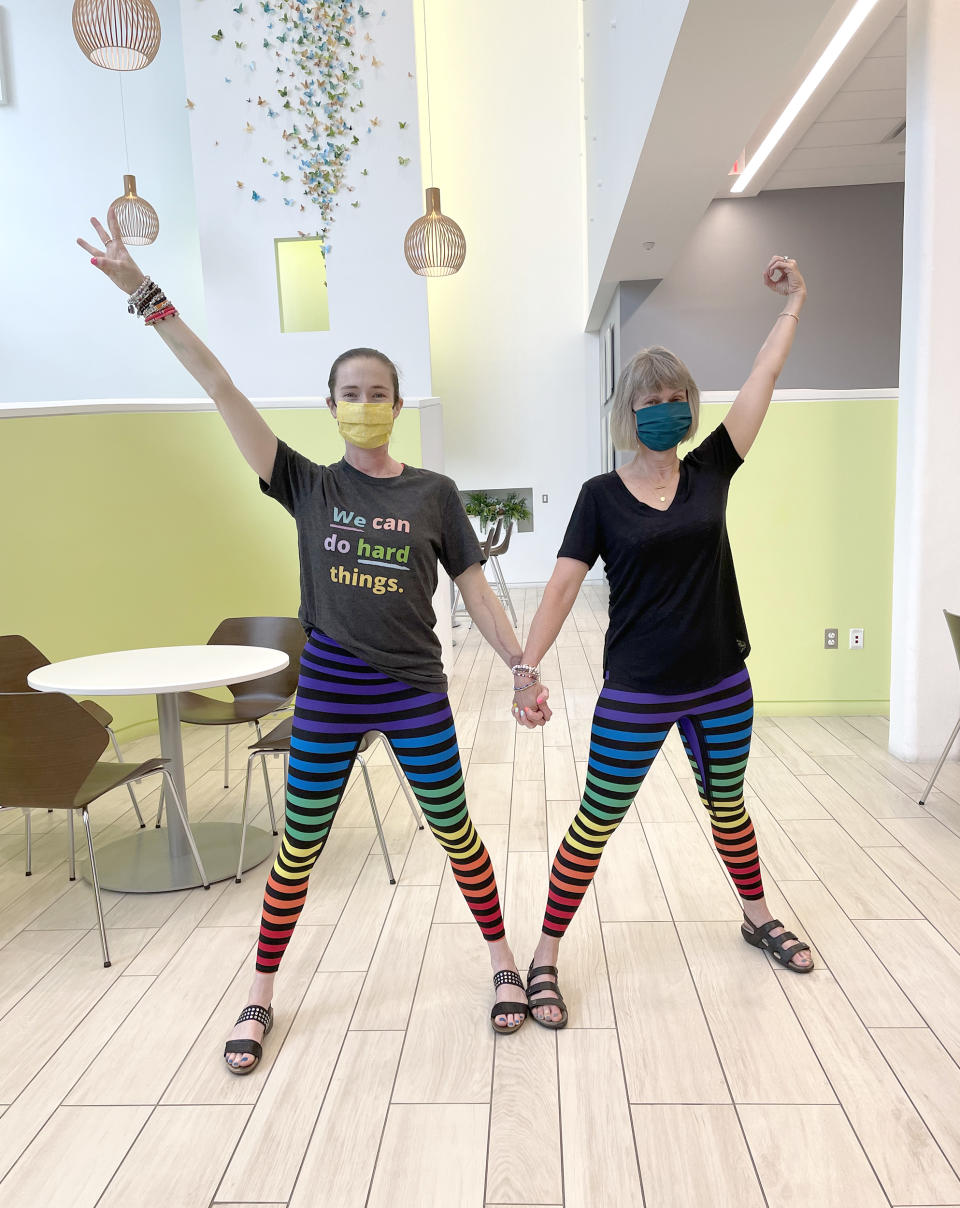35-year-old’s canker sore wouldn’t heal. It was stage 4 tongue cancer
In the fall of 2020, Katie Drablos noticed a canker sore on the back of her tongue that wouldn’t go away. As the pain increased, she visited urgent care, wondering if it was a COVID-19 symptom. It wasn’t, and when she didn’t improve, she learned why: She had tongue cancer.
“I was not in the age group or having lived a life that would leave me to be privy to something like oral cancer,” 35-year-old dancer and choreographer from New York City told TODAY. “By sharing my story, maybe someone can feel less alone and feel more able to express their feelings and reach out if they need help so we can all get through the tough days and keep finding joy.”
Canker sore that won’t go away
Drablos couldn’t see the canker sore, but she felt it, a tiny spot on the back-left side of her tongue that at first only felt painful every once in a while. When she visited the dentist in November 2020, she didn’t even ask about it because it wasn’t too annoying yet. When she’d eat, though, she sometimes felt a twinge of pain. By January 2021, the pain was almost constant.
“What was visible on the outside of my tongue was this sore that was weird looking,” she explained. “Because of the placement, it was hard for me to see it. If it had been on the tip of my tongue, I’d probably would have been like, ‘Oh that doesn’t exactly look like a normal canker sore.’”

After so much pain, she visited urgent care, and the doctor prescribed antibiotics for what he thought was a cold sore. (Cold sores are caused by the herpes simplex virus Type 1 and can develop inside and outside of the mouth, while the cause of canker sores is not known, and they're only found inside the mouth, according to Penn Medicine.) The medication made her feel better at first, but the discomfort returned.
“I came home from teaching, and my throat was hurting a little bit,” Drablos said. “I was like, 'I need to go to the doctor again because this isn’t going away.'”
She looked at a list of local ear, nose and throat doctors and made an appointment to see Dr. Diana Kirke, an otolaryngologist Mount Sinai Hospital. At the appointment, Kirke had a strong suspicion about what she saw.
“Within one second she was like, ‘We’re going to biopsy this right now,’” Drablos recalled. “(I thought) this was more serious than I predicted.”
Tongue cancer in younger populations
For decades, people who developed tongue cancer seemed mostly similar: men over 60 who smoked and drank throughout their lives.
“We’ve started to see anecdotally in the last 10 years ... a shift to a younger age group, and by younger, I mean below the age of 40, unrelated to previous drinking and smoking history,” Kirke told TODAY. “Early evidence suggests that this rise is true, but we actually don’t have all the data to say it’s true.”

“We are doing some research, trying to look more broadly at whether we’re actually seeing a rise in cancer in the younger age group and understand where it’s rising and why," she added.
Symptoms of tongue cancer, according to Kirke, include:
Persistent tongue pain
An ulcer that lasts more than two to four weeks
Bleeding from the ulcer
“If you have any ulceration in the tongue that lasts longer than two weeks, you absolutely need to get it looked at and not just attribute that to a dental problem or a canker sore,” Kirke said. “If it persists, it needs to be biopsied.”
Often people ignore a canker sore because they’re so common.
“That’s the reason for delayed presentation, especially in the younger population, because they attribute it to, ‘Oh, it’s just a canker sore,’ or, ‘It’s a dental problem,’” Kirke said. “They just wait for it to go away.”
From stage 2 to stage 4 cancer
Drablos’ biopsy indicated she had tongue cancer, and a follow-up scan did not detect any cancer outside of her tongue, meaning she was at stage 2. The doctors decided that removing the lesion on her tongue and dissecting her neck would be the best plan. The neck dissection would make sure they could reach all the cancer if lesions were deeply implanted. Then doctors would need to reconstruct her tongue. The treatment plan felt overwhelming.
“I’m just sort of nodding and trying not to cry,” Drablos said. “She was trying to be comforting. But given the way she was looking at me, it was like she knew how much my life was going to change.”

On March 24, 2021, she underwent her surgery, and on April 1, her 34th birthday, she received a call. They found cancer in her neck, meaning she actually was at stage 4. Grappling with that and her grueling physical recovery felt tough.
“The surgery affected so many parts of my body," Drablos said. "The flap they used to reconstruct my tongue involved major surgery on my left arm, and then they grafted with skin from my left leg,” she said.
In addition to the neck dissection, she also had a tracheostomy, a surgical procedure that creates an opening from the neck into the windpipe, aka the trachea. "I felt like this very wounded being in a lot of ways," she added.
Because the cancer was stage 4, Drablos also underwent radiation and chemotherapy.
“I was just trying to get myself mentally prepared for treatment,” she said. “My tongue definitely freaked me out, the look and the appearance of it.” She remembered it being especially swollen.
She experienced burns from the radiation on her neck and generally felt unwell. But as she finished treatment around June 2021, she started improving. She took walks with her mom to improve her strength and did occupational therapy to learn how to reuse her tongue. Because her tongue has muscles from her arm, it doesn't work as naturally, but she has been able to return to dancing. Many days she’s awed with how far she’s come.

“My body is magnificent, how it can heal,” she said. “I’ll feel really sad about some of the losses but then also incredibly grateful and with a deeper sense of gratitude than I ever had pre-cancer.”For her birthday in 2022, she hosted a dance performance and fundraiser for SPOHNC, which supports people with oral, neck and head cancer. This year, she also hosted two dance shows themed around her tongue cancer journey called "Almost 36." The proceeds benefitted charities for two fellow dancers and cancer patients who died in 2022.
“Dancing has been the best medicine, keeping me mentally feeling like myself, being able to express my emotions,” she said. “(For the fundraiser) I also danced. ... There’s beauty out of the pain.”
This article was originally published on TODAY.com
